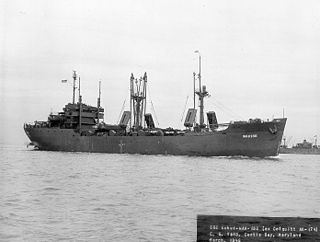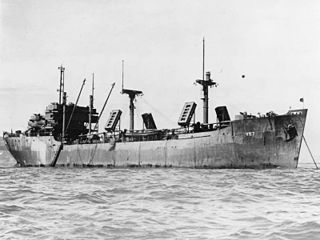Merchant service
In 1947 Caledonia was sold to Bucha Godager & Co., Oslo, Norway. She was renamed Norse Captain.
In 1962 she was sold to the Philippine President Lines Inc., Manila, the Philippines. She was renamed Mabini in 1962 and then President Quezon in 1964.
In 1965 she was again sold, this time to the Seven Brothers Shipping Corp., Manila. She was again renamed, for the last time, Seven Kings. In 1980 she arrived in September at Kaohsiung, Taiwan for demolition by Li Chong Co. Ltd.

USS Crater (AK-70) was the lead ship of her class of converted liberty ship cargo ships in the service of the US Navy in World War II. She was first named after John James Audubon, an American ornithologist, naturalist, and painter. She was renamed and commissioned after the constellation Crater, she was the only ship of the Navy to bear this name.

The USS Alnitah (AK-127) was a Crater-class cargo ship in the service of the US Navy in World War II. Named a spelling variation of the star Alnitak in the constellation Orion, it was the only ship of the Navy to bear this name.

USS Ganymede (AK-104) was a Crater-class cargo ship commissioned by the US Navy for service in World War II. She was responsible for delivering troops, goods and equipment to locations in the war zone. Named after the largest of the moons of Jupiter, Ganymede was the only ship of the Navy to bear this name.

USS Caelum (AK-106) was a Crater-class cargo ship commissioned by the US Navy for service in World War II. Caelum was named after the constellation Caelum. She was responsible for delivering troops, goods and equipment to locations in the Asiatic-Pacific Theater.

USS Crux (AK-115) was a Crater-class cargo ship, converted from a Liberty Ship, commissioned by the US Navy for service in World War II. She was first named after Peter Stuyvesant, a Dutch politician that served as the last Dutch director-general of the colony of New Netherland from 1647 until it was ceded provisionally to the English in 1664. She was renamed and commissioned after Crux, a constellation centered on four stars in the southern sky in a bright portion of the Milky Way. She was responsible for delivering troops, goods and equipment to locations in the war zone.

USS Amador (AK-158) was an Alamosa-class cargo ship commissioned by the US Navy for service in World War II. She was responsible for delivering troops, goods and equipment to locations in the war zone.

USS Beaverhead (AK-161) was an Alamosa-class cargo ship commissioned by the U.S. Navy for service in World War II. She was responsible for delivering troops, goods and equipment to locations in the war zone.

USS Bullock (AK-165) was an Alamosa-class cargo ship commissioned by the U.S. Navy for service in World War II. She was responsible for delivering troops, goods and equipment to locations in the war zone.

USS Cabell (AK-166) was an Alamosa-class cargo ship commissioned by the US Navy for service in World War II. She was responsible for delivering troops, goods and equipment to locations in the war zone.
USS Charlevoix (AK-168) was an Alamosa-class cargo ship commissioned by the U.S. Navy for service in World War II. She was responsible for delivering troops, goods and equipment to locations in the war zone.
USS Chicot (AK-170) was an Alamosa-class cargo ship commissioned by the US Navy for service in World War II. She was responsible for delivering troops, goods and equipment to locations in the war zone.
USS Clarion (AK-172) was an Alamosa-class cargo ship commissioned by the U.S. Navy for service in World War II. She was responsible for delivering troops, goods and equipment to locations in the war zone.

USCGC Kukui (WAK-186) was a Maritime Commission Type C1-M small cargo ship launched 21 January 1945, by Froemming Brothers, Milwaukee, Wisconsin, transferred to the Navy and commissioned and designated as USS Colquitt (AK-174) 22 September 1945. Two days later the ship was transferred to the Coast Guard for operation before being permanently transferred on 11 March 1946. Renamed Kukui and designated WAK-186 the ship was the largest in the Coast Guard with notable service installing, servicing and supplying the Loran-A and Loran-C electronic navigation chain stations in the Pacific until March 1972. The ship was transferred to the Philippines to serve as the Philippine Navy's supply ship BRP Mactan (TK90) until June 2001.

USS Pontotoc (AK-206/AG-94/AVS-7) was an Alamosa-class cargo ship acquired by the US Navy shortly before the end of World War II. She was converted into a Gwinnett-class aviation stores issue ship to carry aviation parts and spares, and to issue them to the US Pacific Fleet and activities as needed.

USS Poinsett (AK-205) was an Alamosa-class cargo ship acquired by the US Navy just prior to the end of World War II. She carried supplies and ammunition to the Pacific Ocean battle areas and was awarded one battle star for her operations in the Borneo area.
USS Fairfield (AK-178) was an Alamosa-class cargo ship acquired by the U.S. Navy during the final months of World War II. She served in the Pacific Ocean theatre of operations and was decommissioned shortly after war’s end.
USS Gadsden (AK-182) was an Alamosa-class cargo ship acquired by the U.S. Navy during the final months of World War II. She served the Pacific Ocean theatre of operations for a short period of time before being decommissioned and returned to the U.S. Maritime Administration.
USS Glacier (AK-183) was an Alamosa-class cargo ship acquired by the U.S. Navy during the final months of World War II. She served in the Pacific Ocean theatre of operations for a short period of time before being decommissioned and returned to the U.S. Maritime Administration for dispositioning.
USS Kenosha (AK-190) was an Alamosa-class cargo ship that served the US Navy during the clean-up phase of World War II. When her service was no longer required in 1946, she was decommissioned and returned to the U.S. Maritime Commission where she was sold to the Kingdom of Norway in 1947.

USS Screven (AK-210) was an Alamosa-class cargo ship that was constructed for the US Navy during the closing period of World War II. She served in the Pacific Ocean theatre of operations and returned home in 1946 to be placed into the "mothball fleet" where she remained until sold in 1947 for commercial maritime service.
This page is based on this
Wikipedia article Text is available under the
CC BY-SA 4.0 license; additional terms may apply.
Images, videos and audio are available under their respective licenses.












